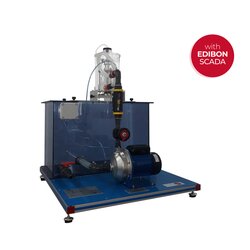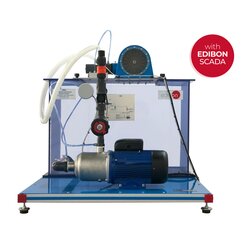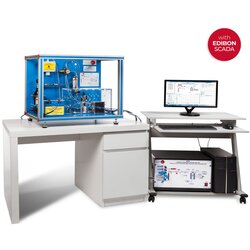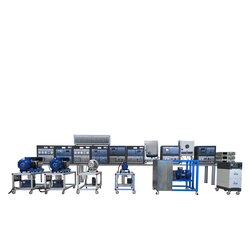Computer Controlled PEM Fuel Cell Advanced Unit (EC6C)



PL-344197
The “EC6C” Computer Controlled PEM Fuel Cell Advanced Unit, developed by EDIBON, is designed to provide students with a comprehensive understanding of proton exchange membrane (PEM) fuel cell technology. The unit enables the calculation of critical parameters such as power density, polarization curves, and efficiency, and it allows for the study of how these parameters change depending on reagent consumption and power output.
The unit comes with a stack of 72 PEM cells, rated at 1000 W. These cells are designed with a channeled plate shape that facilitates the flow of air and hydrogen through the membrane, which generates the release of electrons. The cells are self-humidifying and do not require external humidification. The integrated fan ensures that the stack operates at the proper temperature by supplying the necessary airflow.
Hydrogen storage is a critical component of this system. The unit includes two pressure regulators: one for regulating the outlet pressure of the hydrogen bottle (5 – 50 bar) and another to control the inlet pressure to the stack (0 – 1 bar) from the metal hydride bottle. To manage hydrogen flow, the unit features two solenoid valves: one for controlling the hydrogen inlet before the stack and the other at the outlet to purge excess water and hydrogen to ensure proper operation.
For studying electrical energy generation, the unit includes a load regulation system, allowing for the generation of characteristic operational curves, which can be compared with theoretical data. The entire electrical circuit is safeguarded by a short-circuit unit to protect against overcurrent (30 A) and low voltage shutdown (36 V). Additionally, a hydrogen leak detector is included, with a detection range from 0 – 2% Vol and 0 – 100% L.E.L. (Lower Explosive Limit).
The unit is fully integrated with EDIBON's SCADA-based Computer Control System. It features a Control Interface Box, a Data Acquisition Board, and specialized software for process control, data acquisition, and real-time parameter management, providing complete control and analysis of fuel cell operation.
- EC6C. Unit:
- Bench-top unit.
- Anodized aluminum frame and panels made of painted steel.
- Main metallic elements made of stainless steel.
- Diagram in the front panel with distribution of the elements similar to the real one.
- Pressure regulator for the hydrogen inlet at the PEM fuel cell.
- Pressure regulator for the H2 bottle.
- Solenoid valve to supply H2.
- Purge solenoid valve.
- Suitable tubes and hoses for use with H2 with a high safety factor.
- Load module.
- Battery and charger
- Fuel cell stack
- Instrumentation
- Safety measures and protections
The complete unit includes as well:
- Advanced Real-Time SCADA.
- Open Control + Multicontrol + Real-Time Control.
- Specialized EDIBON Control Software based on LabVIEW.
- National Instruments Data Acquisition board.
- Calibration exercises, which are included, teach the user how to calibrate a sensor and the importance of checking the accuracy of the sensors before taking measurements.
- Projector and/or electronic whiteboard compatibility allows the unit to be explained and demonstrated to an entire class at one time.
- Capable of doing applied research, real industrial simulation, training courses, etc.
- Remote operation and control by the user and remote control for EDIBON technical support, are always included.
- Totally safe, utilizing 4 safety systems (Mechanical, Electrical, Electronic and Software).
- Designed and manufactured under several quality standards.
- Optional ICAI software to create, edit and carry out practical exercises, tests, exams, calculations, etc. Apart from monitoring user’s knowledge and progress reached.
- This unit has been designed for future expansion and integration. A common expansion is the EDIBON Scada-Net (ESN) System which enables multiple students to simultaneously operate many units in a network.
- EC6C/CIB. Control Interface Box.
- EC6C/CCSOF. Computer Control + Data Acquisition + Data Management Software.
- Cables and Accessories, for normal operation.
- Manuals: This unit is supplied with 8 manuals. Required services, Assembly and Installation, Interface and Control software, Starting-up, Safety, Maintenance, Calibration and Practices manuals.
EXERCISES AND PRACTICAL POSSIBILITIES TO BE DONE WITH THE MAIN ITEMS
- Study of the main principles of a proton exchange fuel cell (PEM) operation.
- Study of the structure and main principles of a metal hydride cylinder.
- Calculation of the efficiency of a PEM fuel cell.
- Study of the influence of air consumption and hydrogen consumption in the efficiency of a PEM fuel cell.
- Study of the power density of a PEM fuel cell.
- Representation of the polarization curve of a PEM fuel cell.
- Determination of the voltage and current density characteristics of a PEM fuel cell.
- Influence of hydrogen consumption in the electric power generation.
- Study of the influence of the generated power in the efficiency of a PEM fuel cell.
- Study of the influence of the reagents’ flows in the generation of electrical power.
- Study of the use of reagents and transport phenomena.
What is this?
These percentage scores are an average of 0 user reviews. To get more into detail, see each review and comments as per below
If you have used this product, support the community by submitting your review



